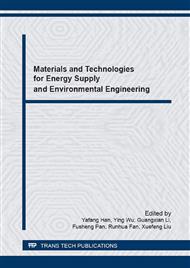[1]
T. Saga, Advances in crystalline silicon solar cell technology for industrial mass production, NPG Asia Mater. 2 (2010) 96–102.
DOI: 10.1038/asiamat.2010.82
Google Scholar
[2]
W. Li, T. Wu. R. Jiao, B. -P Zhang, S. Li, Y. Zhou, L. Li, Effects of silver nanoparticles on the firing behavior of silver paste on crystalline silicon solar cells, Colloid Surf. A-Physicochem. Eng. Asp. 466 (2015) 132–137.
DOI: 10.1016/j.colsurfa.2014.11.018
Google Scholar
[3]
D.K. Schroder, D.L. Meier, Solar cell contact resistance–a review, IEEE Trans. Electron Dev. 31 (1984) 637–647.
DOI: 10.1109/t-ed.1984.21583
Google Scholar
[4]
A. Kalio, M. Leibinger, A Filipovic, K. Krüger, M. Glatthaar, J. Wilde, Development of Pb-free silver ink for front contact metallization, Sol. Energy Mater. Sol. Cells. 106 (2012) 51–54.
DOI: 10.1016/j.solmat.2012.05.044
Google Scholar
[5]
Y.N. Ko, H.Y. Koo, J.H. Yi, J.H. Kim, Y.C. Kang, Characteristics of Pb-based glass frit prepared by spray pyrolysis as the inorganic binder of silver electrode for Si solar cells, J. Alloys Compd. 490 (2010) 582–588.
DOI: 10.1016/j.jallcom.2009.10.091
Google Scholar
[6]
Q. Che, H. Yang, L. Lu, Y. Wang, A new environmental friendly silver front contact paste for crystalline silicon solar cells, J. Alloys Compd. 549 (2013) 221–225.
DOI: 10.1016/j.jallcom.2012.09.080
Google Scholar
[7]
S.B. Cho, K. K Hong, B. M Chung, J. Y Huh, Influence of firing ambience on fire-through silver contact metallization for crystalline silicon solar cells, in: 34th IEEE Photovoltaic Specialists Conference, PVSC 2009, Institute of Electrical and Electronics Engineers Inc., Philadelphia, PA, United states, 2009, pp.766-769.
DOI: 10.1109/pvsc.2009.5411172
Google Scholar
[8]
Y. Ren, Y. Yang, T. Bao, C. Fan, G. Chen, Investigation of the effect of forming gas annealing on front silver electrodes of c-Si solar cells, Surf. Interface Anal. 44 (2012) 856-862.
DOI: 10.1002/sia.4918
Google Scholar
[9]
L.M. Porter, A. Teicher, D.L. Meier, Phosphorus-doped, silver-based pastes for self-doping ohmic contacts for crystalline silicon solar cells, Sol. Energy Mater. Sol. Cells. 73 (2002) 209–219.
DOI: 10.1016/s0927-0248(01)00126-x
Google Scholar
[10]
M.M. Hilali, A. Rohatgi, S Asher, Development of screen-printed silicon solar cells with high fill factors on 100 Ω/sq emitters, IEEE Trans. Electron Dev. 51 (2004) 948-955.
DOI: 10.1109/ted.2004.828280
Google Scholar
[11]
Y. Yang, S. Seyedmohammadi, U. Kumar, D. Gnizak, E. d. Graddy, A. Shaikh, Screen printable silver paste for silicon solar cells with high sheet resistance emitters, Energy Procedia. 8 (2011) 607-613.
DOI: 10.1016/j.egypro.2011.06.190
Google Scholar
[12]
S.B. Rane, P.K. Khanna, T. Seth, G.J. Phatak, D.P. Amalnerkar, B.K. Das, Firing and processing effects on microstructure of fritted silver thick film electrode materials for solar cells, Mater. Chem. Phys. 82 (2003) 237-245.
DOI: 10.1016/s0254-0584(03)00236-0
Google Scholar
[13]
G. Schubert, F. Huster, P. Fath, Physical understanding of printed thick-film front contacts of crystalline Si solar cells-review of existing models and recent developments, Sol. Energy Mater. Sol. Cells. 90 (2006) 3399-3406.
DOI: 10.1016/j.solmat.2006.03.040
Google Scholar
[14]
K.K. Hong, S.B. Cho, J.S. You, J. W Jeong, S.M. Bea, J.Y. Huh, Mechanism for the formation of Ag crystallites in the Ag thick-film contacts of crystalline Si solar cells, Sol. Energy Mater. Sol. Cells. 93 (2009) 898-904.
DOI: 10.1016/j.solmat.2008.10.021
Google Scholar
[15]
K.K. Hong, S.B. Cho, J. Y Huh, H.J. Park, J.W. Jeong, Role of PbO-based glass frit in Ag thick-film contact formation for crystalline Si solar cells, Met. Mater. Int. 15 (2009) 307-312.
DOI: 10.1007/s12540-009-0307-1
Google Scholar
[16]
H. Yu, L. Li, Y. Zhang, Silver nanoparticle-based thermal interface materials with ultra-low thermal resistance for power electronics applications, Scripta Mater. 66 (2012) 931-934.
DOI: 10.1016/j.scriptamat.2012.02.037
Google Scholar
[17]
G. Guo, W. Gan, F. Xiang, J. Zhang, H. Zhou, H. Liu, J. Luo, Effect of dispersibility of silver powders in conductive paste on microstructure of screen-printed front contacts and electrical performance of crystalline silicon solar cells, J. Mater. Sci.: Mater. Electron. 22 (2011).
DOI: 10.1007/s10854-010-0172-1
Google Scholar
[18]
K.S. Moon, H. Dong, R. Maric, S. Pothukuchi, A. Hunt, Y. Li, C.P. Wong, Thermal behavior of silver nanoparticles for low-temperature interconnect applications, J. Electro. Mater. 34 (2005) 168-175.
DOI: 10.1007/s11664-005-0229-8
Google Scholar
[19]
Q. Che, H. Yang, L. Lu, Y. Wang, Nanoparticles-aided silver front contact paste for crystalline silicon solar cells, J. Mater. Sci.: Mater. Electron. 24 (2013) 524-528.
DOI: 10.1007/s10854-012-0941-0
Google Scholar
[20]
S.H. Park, D.S. Seo, J.K. Lee, Preparation of Pb-free silver paste containing nanoparticles, Colloid Surf. A-Physicochem. Eng. Asp. 197 (2008) 313–314.
DOI: 10.1016/j.colsurfa.2007.04.092
Google Scholar
[21]
D.S. Seo, S.H. Park, J.K. Lee, Sinterability and conductivity of silver paste with Pb-free frit, Curr. Appl. Phys. 9 (2009) S72–S74.
DOI: 10.1016/j.cap.2008.08.011
Google Scholar
[22]
J.H. Yi, H.Y. Koo, J.H. Kim, Y.N. Ko, Y.J. Hong, Y.C. Kang, H.M. Lee, Pb-free glass frits prepared by spray pyrolysis as inorganic binders of Al electrodes in Si solar cells, J. Alloys Compd. 509 (2011) 6325–6331.
DOI: 10.1016/j.jallcom.2011.03.085
Google Scholar
[23]
J.H. Kim, H.Y. Koo, Y.N. Ko, Y.C. Kang, Characteristics of Bi-based glass frit having similar mean size and morphology to those of silver powders at high firing temperatures, J. Alloys Compd. 497 (2010) 259–266.
DOI: 10.1016/j.jallcom.2010.03.022
Google Scholar
[24]
S.J. Jeon, S.M. Koo, S. A Hwang, Optimization of lead-and cadmium-free front contact silver paste formulation to achieve high fill factors for industrial screen-printed Si solar cells, Sol. Energy Mater. Sol. Cells. 93 (2009) 1103-1109.
DOI: 10.1016/j.solmat.2009.01.003
Google Scholar
[25]
A. Hirose, H. Tatsumi, N. Takeda, Y. Akada, T. Ogura, E. Ide, T. Morita, A novel metal-to-metal bonding process through in-situ formation of Ag nanoparticles using Ag2O microparticles, J. Phys. Conf. Ser. 165 (2009) 012074–012079.
DOI: 10.1088/1742-6596/165/1/012074
Google Scholar
[26]
T. Morita, Y. Yasuda, E. Ide, Y. Akada, A. Hirose, Bonding technique using micro-scaled silver-oxide particles for in-situ formation of silver nanoparticles, Mater. Trans. 49 (2008) 2875–2880.
DOI: 10.2320/matertrans.mra2008269
Google Scholar


